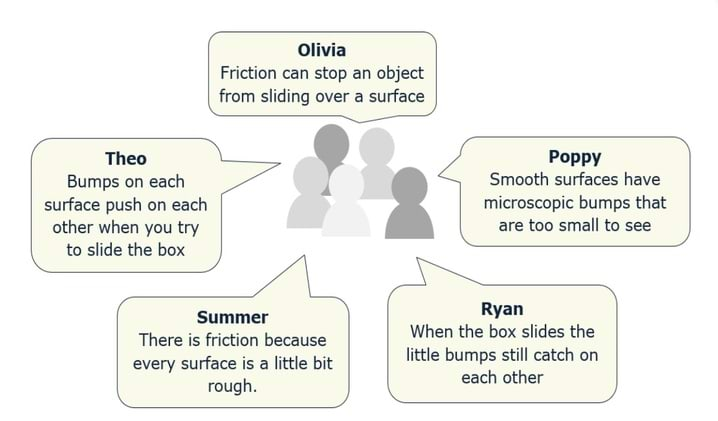Friction is the force generated by an interaction between two objects. This is different to most forces which cause the interaction (Hart, 2002). This perhaps led to the finding from a study of thirty-eight 12-16 year olds, that fewer than half of students identify friction as a force (Stead and Osborne, 1980). Driver et al (1994) suggest that many students think of forces only as ‘getting things going’ and not as ‘stopping things’.
A later study of forty-seven secondary students, by Stead and Osborne (1981), showed that students also think that:
- friction depends on movement (seventeen students)
- friction is directionless, as distinct from a force that opposes motion (a few students)
In Stead and Osborne’s (1980) study they found that half of 13-year old students also thought of friction as rubbing. But friction is also acting between objects that are not moving. Text books for 11-14 year old students often talk about shoes or tyres having a good grip. The implication is that the shoe or tyre ‘has a lot of friction’, which It does not. Rather it is good at generating friction when it is pushed along a surface, and often the friction it generates prevents it from moving.
This question challenges students to describe how the physical irregularities on surfaces cause friction.
This task is intended for discussion in pairs or small groups. It can be done as a pencil and paper exercise or projected onto a screen. Students should read the statements and follow the instructions on either the worksheet or the PowerPoint. Listening in to the conversations of each group will often give you insights into how your students are thinking. Each member of a group should be able to report back to the class. Feedback from each group can be used, with careful teacher questioning, to bring out a clear description or explanation of the science.
Differentiation
The quality of the discussions can be improved with a careful selection of groups; or by allocating specific roles to students in the each group. For example, you may choose to select a student with strong prior knowledge as the scribe, and forbid them from contributing any of their own answers. They may question the others and only write down what they have been told. This strategy encourages contributions from more members of each group.
NB in any class, small group discussions typically improve over time and a persistence with this strategy is often very successful in the medium to long term.
Microscopic, and not so microscopic bumps catch when it an attempt is made to slide the box over the surface. The harder the box is pushed, the harder the surface pushes back - acting through the bumps. This is true until the friction force reaches a maximum value and cannot resist any more, so the box starts to move. As the box moves, at whatever speed, the friction remains roughly the same, at its maximum value.
A suitable response activity could be for students to be given the opportunity to explain the scientific way of thinking in their own terms, for example question two on the student worksheet. Working to improve answers in pairs or small groups can encourage social construction of the scientific understanding through dialogue.
If students need to consolidate their understanding of what causes friction, it may help to apply these ideas to practical situation.
The following BEST ‘response activity’ could be used in follow-up to this diagnostic question:
- Response activity: Testing friction

